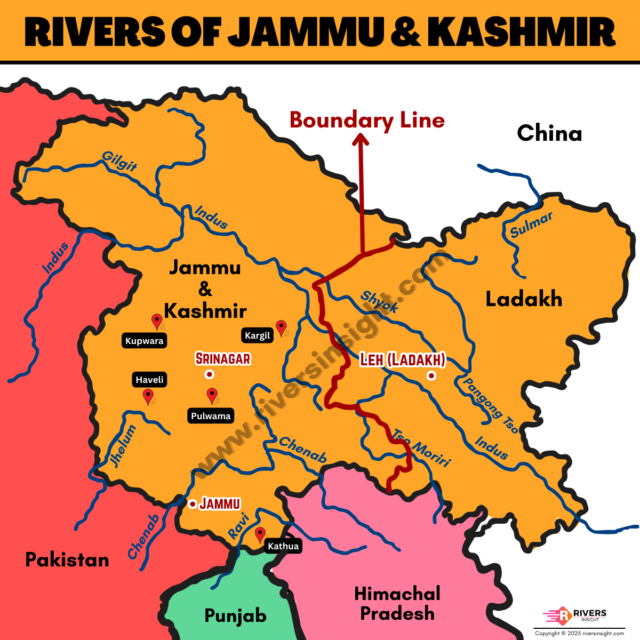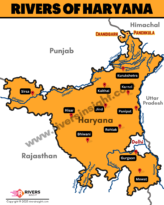Rivers of Jammu & Kashmir and Ladakh with Map & Facts
Jammu and Kashmir and Ladakh are northern Union Territories of India, sharing borders with Himachal Pradesh, Punjab, and international borders with Pakistan and China. These regions have many important rivers that begin in the Himalayas and flow through valleys, shaping the terrain and providing water to towns and farmlands.
This article covers the major rivers of Jammu and Kashmir and Ladakh, including the Indus, Jhelum, Chenab, Tawi, and Zanskar. It includes key facts, a helpful map, and information about tributaries and dams. Whether you are a student or a geography enthusiast, this article on the Rivers of Jammu and Kashmir and Ladakh gives useful knowledge in a simple way.
River Basins in Jammu
- Indus Basin – Includes Indus, Shyok, Zanskar, Nubra, Suru
- Jhelum Basin – Includes Jhelum, Lidder, Sind, Pohru
- Chenab Basin – Includes Chenab, Tawi, and Ravi rivers
These river basins are part of the larger Indus River System shared between India and Pakistan under the Indus Waters Treaty.
Major Rivers of Jammu & Kashmir and Ladakh
1. Indus River
- Origin: Tibetan Plateau, near Lake Mansarovar
- Entry Point in India: Demchok, Ladakh
- Length in India: About 1,114 km
- Region Covered: Ladakh and some parts of Gilgit-Baltistan (administered by Pakistan)
- Drainage: Flows westward into Pakistan
The Indus River is the longest river in Ladakh and one of the longest rivers in India. It flows through Leh and supports agriculture in the arid region of Ladakh.
👉 Full details: Read our in-depth Indus River guide
2. Jhelum River
- Origin: Verinag Spring, Anantnag, Kashmir
- Length: Around 725 km
- Course: Flows through Srinagar and Wular Lake
- Tributaries: Lidder, Sind, Pohru, Vishav
The Jhelum River is the most significant river of the Kashmir Valley. It flows through the heart of Srinagar and eventually joins the Chenab River in Pakistan.
3. Chenab River
- Origin: Confluence of Chandra and Bhaga rivers at Tandi (Himachal Pradesh)
- Length: Around 960 km
- Entry Point in J&K: Paddar Valley in Kishtwar
- Significance: Hydroelectric projects and irrigation
The Chenab River flows through steep valleys and is known for its deep gorges. It plays a vital role in the hydroelectric power sector.
4. Tawi River
- Origin: Dudu, Seoj Dhar Range (Udhampur district)
- Length: About 141 km
- Significance: Main source of water for Jammu city
The Tawi River is a major river in the Jammu region and is considered sacred by the local people.
5. Ravi River
- Origin: Bara Bhangal, Himachal Pradesh
- Entry into J&K: Kathua district
- Use: Irrigation and border demarcation
6. Shyok River
- Origin: Rimo Glacier (Siachen area)
- Course: Nubra Valley → Baltistan (Pakistan)
- Tributary of: Indus River
7. Zanskar River
- Origin: Zanskar range
- Joins: Indus near Nimmu (close to Leh)
- Famous For: Chadar Trek in winter
- Tributary of: Indus River
Other Rivers in Jammu Kashmir and Ladakh
- Nubra River – Tributary of Shyok, flows through Nubra Valley
- Dras River – Originates in Dras Valley, joins Suru
- Suru River – Tributary of Indus, flows near Kargil
- Sind River – Tributary of Jhelum, important in Ganderbal
- Lidder River – Beautiful river of Pahalgam, joins Jhelum
Longest River of Jammu & Kashmir
- The Indus River is the longest river in the region and covers the maximum distance in Ladakh.
- The Chenab River is the second longest and flows through the Jammu region with strong current and deep valleys.
Major Dams in Jammu & Kashmir
Jammu & Kashmir have several important dams, mainly for hydroelectric power and water storage. Most of these are built on the Chenab and Jhelum Rivers.
- Baglihar Dam – On the Chenab River in Ramban; 900 MW capacity
- Salal Dam – On the Chenab River in Reasi; 690 MW
- Dul Hasti Project – Chenab River, Kishtwar; 390 MW
- Uri Dam – On the Jhelum River near Baramulla; 480 MW
- Lower Jhelum Project – On Jhelum River; 105 MW
- Kiru & Kwar Projects – Under construction on the Chenab; over 1,100 MW combined




